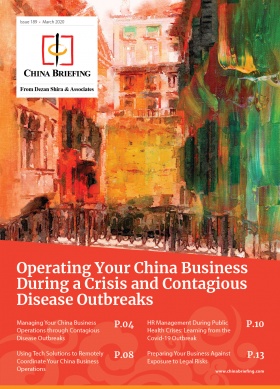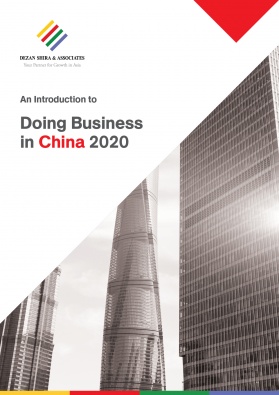China’s Two Sessions 2020: What Have We Learnt So Far
China’s top leaders convened for the annual Two Sessions meetings on Thursday, following over two months of delays due to the coronavirus (COVID-19) outbreak.
The Two Sessions refer to the annual meetings of the Chinese People’s Political Consultative Conference (CPPCC) – an advisory body of over 2,000 members – and the National People’s Congress, China’s top legislative body. They are China’s most important annual political meetings, highlighted by the delivery of the Work Report by Premier Li Keqiang, which lays out the government’s agenda and policy priorities for the coming year.
Normally, the Two Sessions are held in March, but this year they were delayed because of COVID-19. After getting the virus largely under control, however, China’s top leaders finally convened – though all delegates besides the elite Politburo Standing Committee donned surgical masks to prevent infections.
The Two Sessions are always of interest to foreign investors, as the government announces key economic policies, such as the annual GDP growth target. This year the Two Sessions takes on added importance, as investors wait to see what the government will announce to revitalize China’s economy out of a coronavirus-induced crisis.
Here, we look at the key announcements unveiled by China’s leaders at the ongoing Two Sessions meetings.
Growth target
In the Work Report, Li announced that China would not set a GDP growth target for 2020, marking the first time the government did not set a target since records began in 1990.
According to Li, the government opted not to set a growth target because of the high level of uncertainty caused by COVID-19 and its effects on the global economy. Before COVID-19 struck, most analysts believed that the government would set its growth target at “around six percent”.
Last year, China set a growth target of 6-6.5 percent, which it ultimately achieved by growing 6.1 percent. In the first quarter of this year, however, China’s economy contracted by 6.8 percent, per official statistics, and some analysts expect another contraction in the second quarter.
The annual announcement of the GDP growth target is one of the most anticipated features of the Two Sessions meetings. Prior to the announcement, some observers predicted that Li would announce either a lower than usual target or one that combined both 2020 and 2021.
Despite the attention given to the announcement, many economists have long argued that China’s leaders should abandon the tradition of setting a target. According to them, setting a specific growth target creates incentives for inefficient government spending and short-term thinking while ignoring the deeper structural issues affecting the economy and people’s needs.
Nevertheless, while GDP has well-known flaws as a statistic, in China the growth target takes added importance. Because the government plays a significant role in the economy and faces political pressure to meet publicly stated goals, the GDP growth target in China is not just a predictor of growth output but also an input signal of forthcoming government credit and spending.
Accordingly, while Li stated that the government will take strong measures to support employment, there remains uncertainty over how far they will go to stimulate the economy. It may also be a signal that the government is prepared to accept a low level of growth in 2020.
Fiscal stimulus
Li announced a fiscal stimulus package of almost RMB 3.6 trillion (US$506 billion) to lead China’s economy recovery following the COVID-19 disruption. Accordingly, the government is increasing the budget fiscal deficit to an all-time high of 3.6 percent of GDP, compared to 2.8 percent in 2019.
As part of this package, the government will issue RMB 1 trillion (US$140 billion) worth of special treasury bonds and increase the local government special bond quota to RMB 3.75 trillion (US527 billion) – an RMB 1.6 trillion (US$225 billion) increase year-on-year.
These bonds, in particular, are a key source for infrastructure funding, which is a method the Chinese government often employs to stimulate growth, such as it did following the 2008 global financial crisis. Rather than traditional infrastructure like bridges and high-speed rail, however, this time around the government will target investments in “new infrastructure,” such as 5G networks and new energy vehicles (NEV) charging stations.
Beyond stimulating growth, government planners are hoping the stimulus will help employment and, as a result, social stability. Li said that the government is seeking to create nine million new urban jobs in 2020.
China’s stimulus package is substantial and similar in size to its 2008 response, which came in at about RMB 4 trillion (US$572 billion). However, China’s economy is significantly larger than it was in 2008, meaning that this stimulus package is a much smaller percentage of GDP. The US, in contrast, has already injected over US$3 trillion into its economy.
While the global economic challenges presented by COVID-19 are arguably larger than the 2008 financial crisis, China is limited by the high levels of debt it accrued to navigate the latter crisis. In light of this issue, the central government has been leading a multi-year debt derisking campaign and has attempted to reduce reliance on government spending for growth.
Other policy announcements
Besides the announcements of the growth target and stimulus, government officials have announced a number of other policies during the Two Sessions.
One major development was the government’s surprise announcement of a national security law for Hong Kong, to be passed in Beijing. Party leaders hope that the law will lead to more stability in Hong Kong, which was beset by protests for much of 2019, but it may also cause more push back from grassroots groups.
Additionally, government officials called for the continuation or deepening of existing policy priorities, some of which may have been in doubt because of COVID-19. For instance, China will establish more free trade zones (FTZ) and bonded areas in central and western regions, further shorten the negative list for guiding foreign investment, cut more taxes, and continue pushing the Belt and Road Initiative overseas.
Further, despite the economic disruption of COVID-19, Li’s work report reiterated the goal of eliminating rural poverty in 2020. A decade ago, the Party announced that it would double 2010 income per capita levels by 2020, while President Xi Jinping has made it a priority to end rural poverty by this year.
Spurred by COVID-19, government officials throughout the Two Sessions meetings have emphasized the importance of improving China’s medical services. In the Work Report, Li stated the reforming China’s disease prevention and control system would be a high priority for the government to accomplish this year.
Moreover, in a speech to delegates from Hubei – the epicenter of the outbreak – Xi stated that improving public health was a national security concern, underscoring its importance. Accordingly, foreign investors can expect reforms of China’s health system and greater investments in the sector this year.
The 2020 Two Sessions is notable for its breaks in tradition, from convening over two months late to the growth target being scrapped. Its implications, however, could stretch beyond the current crisis, as 2020 is also the last year of the current Five Year Plan. As such, the way in which the rest of the year plays out – whether positively or negatively – could influence the drafting of the next Five Year Plan that will shape policies until 2025.
About Us
China Briefing is written and produced by Dezan Shira & Associates. The practice assists foreign investors into China and has done so since 1992 through offices in Beijing, Tianjin, Dalian, Qingdao, Shanghai, Hangzhou, Ningbo, Suzhou, Guangzhou, Dongguan, Zhongshan, Shenzhen, and Hong Kong. Please contact the firm for assistance in China at china@dezshira.com.
We also maintain offices assisting foreign investors in Vietnam, Indonesia, Singapore, The Philippines, Malaysia, Thailand, United States, and Italy, in addition to our practices in India and Russia and our trade research facilities along the Belt & Road Initiative.
- Previous Article Warum China die globale wirtschaftliche Erholung nach COVID-19 anführen könnte
- Next Article China’s Proposed New Security Law in Hong Kong – An Explainer


























